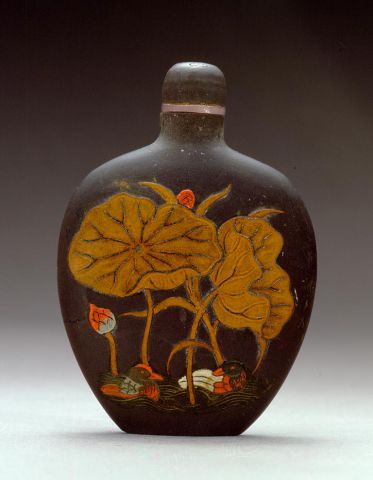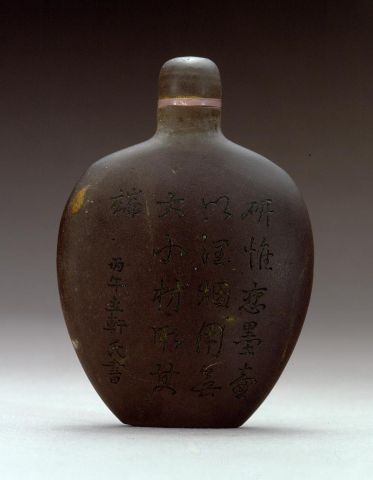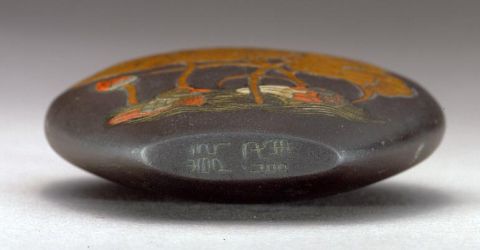


Bottle ID: 219
LACQUERED AND ENAMELED
Date: 1906
Height: 63 mm
Duanstone, inkstone (slate), of flattened shield shape, well hollowed, enameled on one side in lacquer with two mandarin ducks swimming amid lotus leaves, pods, and flowers, the reverse incised with an inscription, reading:
"When polished it should just be for ink, but this bottle is for keeping snuff moist.
What it is used for hs nothing to do with size, so why not choose Duanstone as the material!"
and cyclically dated bingwu year, probably 1906, and the signature, Mr. Lixuan.
Attributed to Duan.
Similar Examples:
Crane Collection nos. 247 and 336
Provenance:
Clare Lawrence Ltd.
Christie's, New York, June 2, 1994, lot 444
This is a unique bottle in a number of ways, highlighted by the fact that almost no similar published examples could be found. Whilst it is more usual to enamel Yixing, a type of stoneware, that is visually similar to inkstone, it is very rare to find inkstone decorated in this manner. The technical difficulties of firing a stone and adhering enamel to its surface may partially account for this. The use of an inscription on the reverse of the bottle is a more typical practice and the inscription here is fairly common, emphasizing that this stone, being porous, is a good container for snuff, presumably because the snuff will stay fresh and moist longer.
Lixuan is either a personal name (zi) or an art name (hao) and there are a number of possibilities here, some more likely than others with bingwu year as the given cyclical date.
The earliest possibility and the most unlikely, is Gan Guobi, a high level official at the end of the Kangxi period, who used Lixuan as his art name. However, the date of 1726 which would be in the Yongzheng period does not fit with this possibility.
There is no-one recorded with this art name in the early 19th century who was composing inscriptions which were used on snuff bottles, however Lixuan was also the hao of Wu Degong (1850-1924), a prominent Taiwanese literatus who served the Qing Court in Taiwan in the 1890s and who had a career as a senior educational figure during the Japanese occupation of China. He was a prolific writer and poet, although not a painter or calligrapher, so may be solely the composer of the inscription on this bottle, in which case the relevant date would be 1906.
In terms of identifying Lixuan there are two further 20th century possibilities. The first is a well-known Taiwanese painter, Lin Yu-shan (1907-2004) whose personal name was Lixuan, and who was famous for painting lotuses, not unlike the ones depicted on this bottle. This would date the bottle, or at least its decoration, to 1966. This date would also fit if Lixuan was the hao of Zhuo Erhuang, a 20th century painter of birds and flowers, and also a music teacher from Putian in Fujian Province. Although his dates are unknown, he was the younger brother of the well-known painter Huang Zhuoran whose dates were 1894-1961.

 English
English 中文
中文